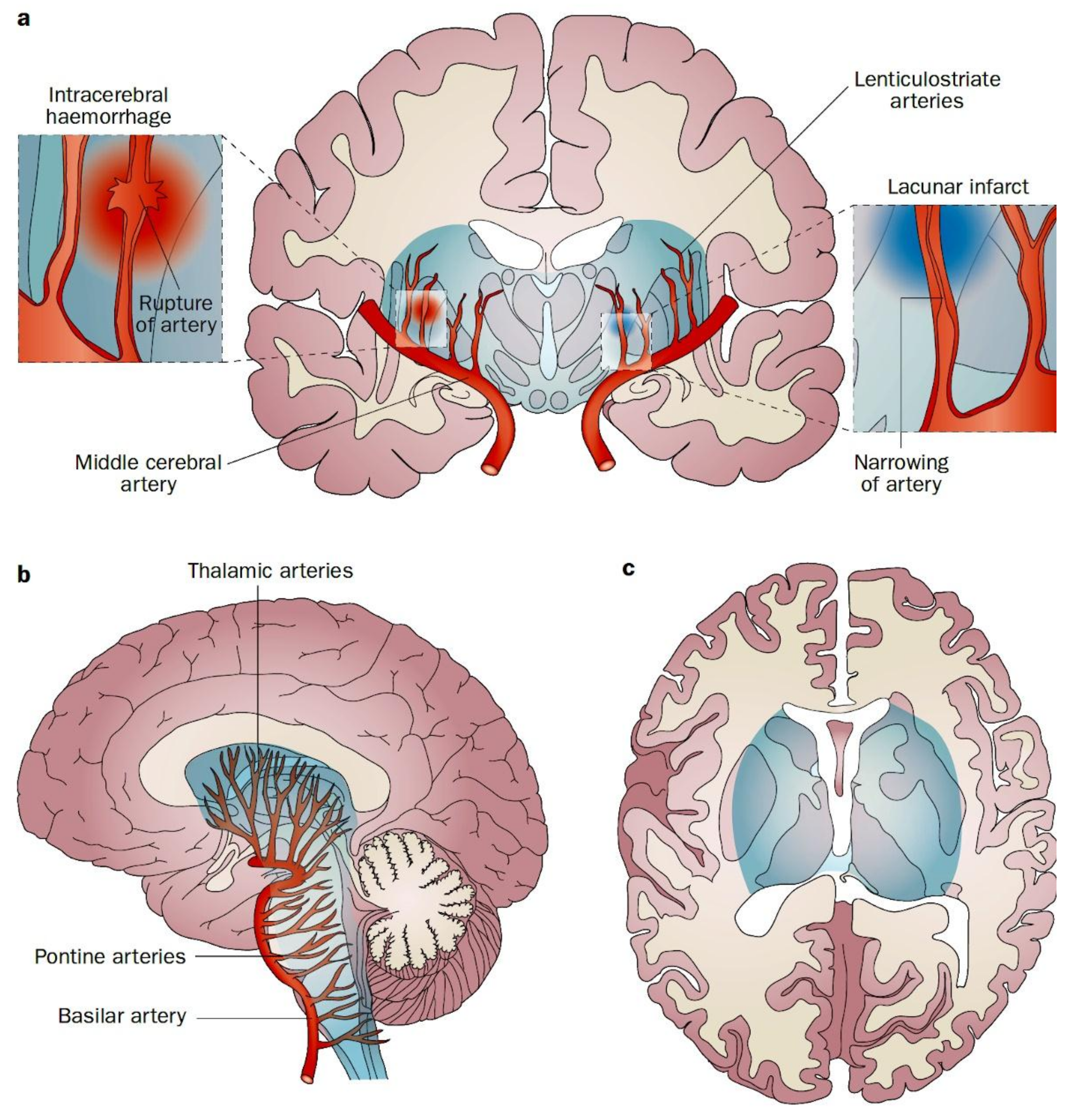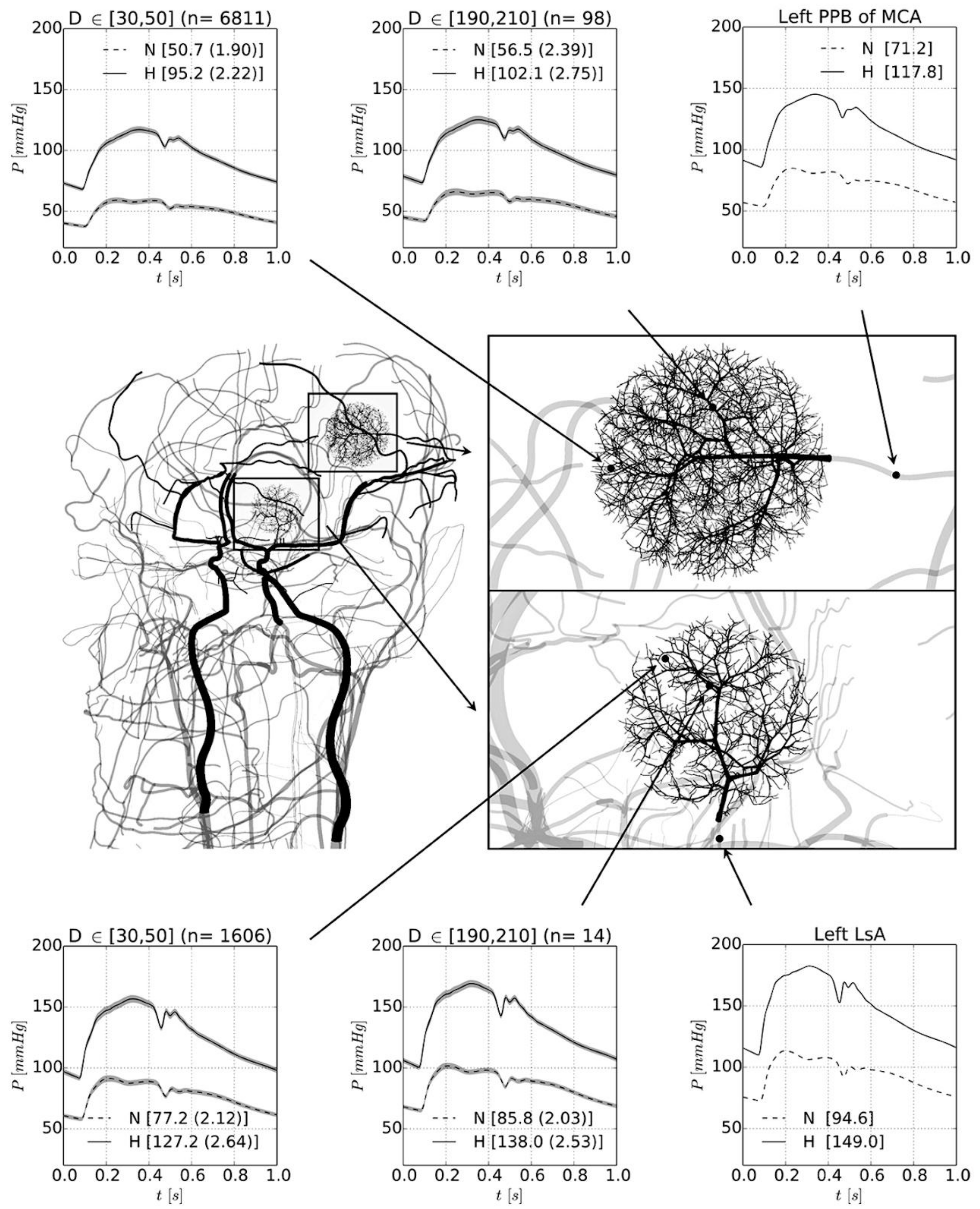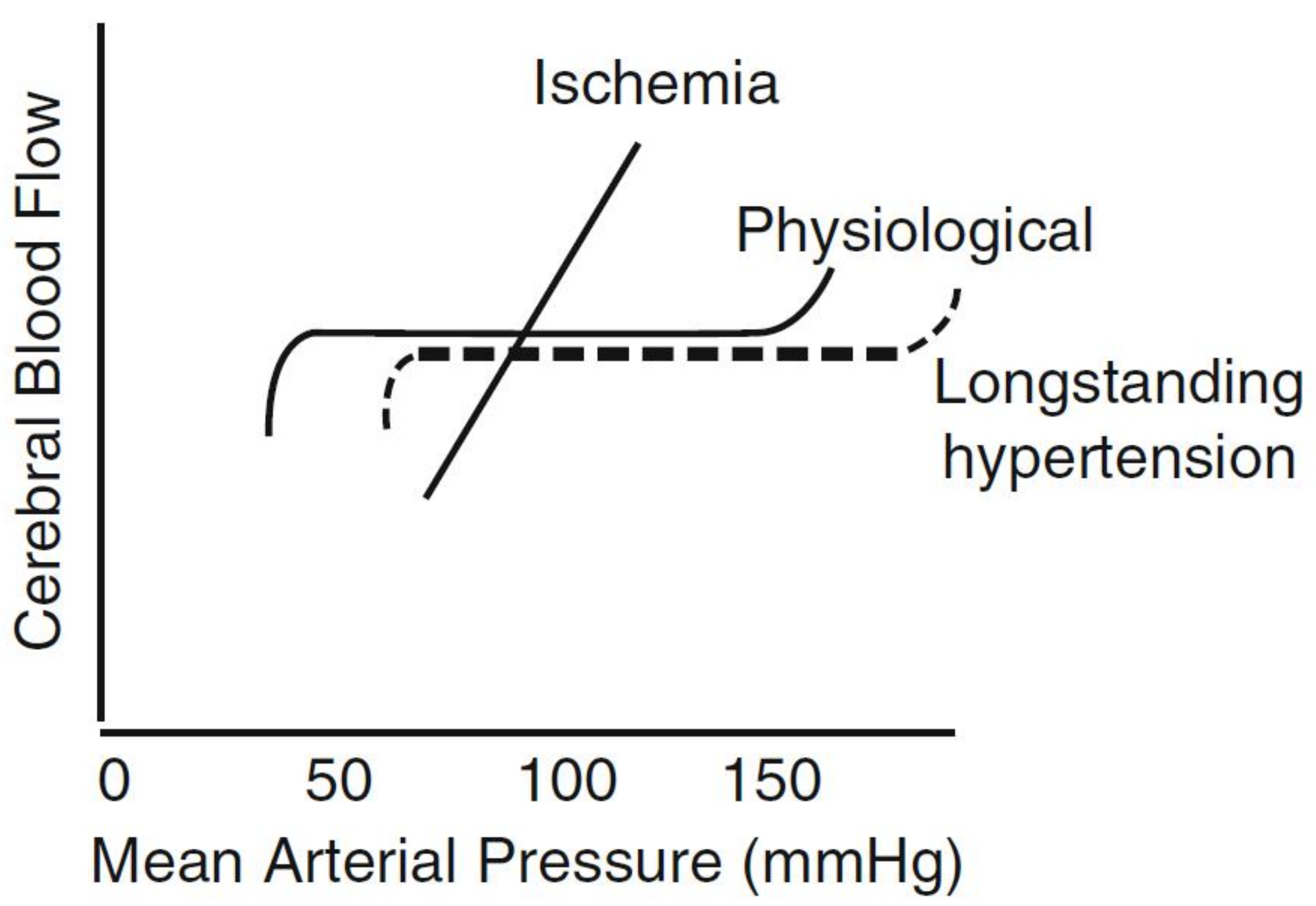Blood Pressure Gradients in the Brain: Their Importance to Understanding Pathogenesis of Cerebral Small Vessel Disease
Abstract
1. Introduction
2. Misuse of the Term “Lacunar Infarction”
3. Blood Pressure Gradients in the Brain
4. Diastolic J Curve with Wide Pulse Pressure
5. Cuff Artefact in Measurement of Blood Pressure
6. Impaired Autoregulation of Cerebral Blood Flow
7. Venous Small Vessel Disease
8. Opportunities for Future Research
9. Summary
10. Conclusions
Funding
Conflicts of Interest
References
- Snowdon, D.A.; Greiner, L.H.; Mortimer, J.A.; Riley, K.P.; Greiner, P.A.; Markesbery, W.R. Brain infarction and the clinical expression of Alzheimer disease. The Nun Study. JAMA 1997, 277, 813–817. [Google Scholar] [CrossRef] [PubMed]
- Whitehead, S.N.; Cheng, G.; Hachinski, V.C.; Cechetto, D.F. Progressive increase in infarct size, neuroinflammation, and cognitive deficits in the presence of high levels of amyloid. Stroke 2007, 38, 3245–3250. [Google Scholar] [CrossRef] [PubMed]
- Thiel, A.; Cechetto, D.F.; Heiss, W.D.; Hachinski, V.; Whitehead, S.N. Amyloid burden, neuroinflammation, and links to cognitive decline after ischemic stroke. Stroke 2014, 45, 2825–2829. [Google Scholar] [CrossRef] [PubMed]
- Fisher, C.M. Lacunar strokes and infarcts: A review. Neurology 1982, 32, 871–876. [Google Scholar] [CrossRef]
- Fisher, C.M. Lacunar infarct of the tegmentum of the lower lateral pons. Arch. Neurol. 1989, 46, 566–567. [Google Scholar] [CrossRef]
- Fisher, C.M. A lacunar stroke. The dysarthria-clumsy hand syndrome. Neurology 1967, 17, 614–617. [Google Scholar] [CrossRef] [PubMed]
- Hachinski, V.C.; Norris, J.W. The Vascular Infrastructure. The Acute Stroke; F.A. Davis: Philadelphia, PA, USA, 1985; pp. 27–40. [Google Scholar]
- Spence, J.D.; Hammond, R. Hypertension and Stroke. In Arterial Hypertension and the Brain as an End-Organ Target; Girouard, H., Ed.; Springer International Publishing: Cham, Switzerland, 2016; pp. 39–54. [Google Scholar]
- Sprint, R.G.; Wright, J.T., Jr.; Williamson, J.D.; Whelton, P.K.; Snyder, J.K.; Sink, K.M. A Randomized Trial of Intensive versus Standard Blood-Pressure Control. N. Engl. J. Med. 2015, 373, 2103–2116. [Google Scholar]
- Sörös, P.; Whitehead, S.; Spence, J.D.; Hachinski, V. Antihypertensive treatment can prevent stroke and cognitive decline. Nat. Rev. Neurol. 2013, 9, 174–178. [Google Scholar] [CrossRef]
- Blanco, P.; Mueller, L.; Spence, J.D. Blood pressure gradients in cerebral arteries: A clue to pathogenesis of cerebral small vessel disease. Stroke Vasc. Neurol. 2017, 2, 108–117. [Google Scholar] [CrossRef]
- McEvoy, J.W.; Chen, Y.; Rawlings, A.; Hoogeveen, R.C.; Ballantyne, C.M.; Blumenthal, R.S.; Coresh, J.; Selvin, E. Diastolic Blood Pressure, Subclinical Myocardial Damage, and Cardiac Events: Implications for Blood Pressure Control. J. Am. Coll. Cardiol. 2016, 68, 1713–1722. [Google Scholar] [CrossRef]
- Park, J.H.; Ovbiagele, B. Post-stroke diastolic blood pressure and risk of recurrent vascular events. Eur. J. Neurol. 2017, 24, 1416–1423. [Google Scholar] [CrossRef] [PubMed]
- Toole, J.F.; Malinow, M.R.; Chambless, L.E.; Spence, J.D.; Pettigrew, L.C.; Howard, V.J.; Sides, E.G.; Wang, C.H.; Stampfer, M. Lowering Plasma Total Homocysteine to Prevent Recurrent Stroke, Myocardial Infarction, and Death in Ischemic Stroke Patients: Results of the Vitamin Intervention for Stroke Prevention (VISP) Randomized Trial. JAMA 2004, 291, 565–575. [Google Scholar] [CrossRef]
- Spence, J.D. Spectral analysis of carotid vs femoral Doppler velocity patterns: A clue to genesis of flow disturbances in cerebral arteries. In Frontiers of Engineering in Health Care; Cohen, B.A., Ed.; Library of Congress Catalog Card: Houston, TX, USA, 1981. [Google Scholar]
- Spence, J.D.; Sibbald, W.J.; Cape, R.D. Pseudohypertension in the elderly. Clin. Sci. Mol. Med. Suppl. 1978, 4, 399s–402s. [Google Scholar] [CrossRef]
- Finnegan, T.P.; Spence, J.D.; Wong, D.G.; Wells, G.A. Blood pressure measurement in the elderly: Correlation of arterial stiffness with difference between intra-arterial and cuff pressures. J. Hypertens. 1985, 3, 231–235. [Google Scholar] [CrossRef]
- Valdes Hernandez Mdel, C.; Maconick, L.C.; Munoz Maniega, S.; Wang, X.; Wiseman, S.; Armitage, P.A.; Doubal, F.N.; Makin, S.; Sudlow, C.L.; Dennis, M.S.; et al. A comparison of location of acute symptomatic vs. ‘silent’ small vessel lesions. Int. J. Stroke 2015, 10, 1044–1050. [Google Scholar] [CrossRef] [PubMed]
- Rufa, A.; Dotti, M.T.; Franchi, M.; Stromillo, M.L.; Cevenini, G.; Bianchi, S.; De Stefano, N.; Federico, A. Systemic blood pressure profile in cerebral autosomal dominant arteriopathy with subcortical infarcts and leukoencephalopathy. Stroke 2005, 36, 2554–2558. [Google Scholar] [CrossRef] [PubMed]
- Pettersen, J.A.; Keith, J.; Gao, F.; Spence, J.D.; Black, S.E. CADASIL accelerated by acute hypotension: Arterial and venous contribution to leukoaraiosis. Neurology 2017, 88, 1077–1080. [Google Scholar] [CrossRef]
- Spence, J.D.; Paulson, O.B. Hypertension and Stroke. In The ABCs of Antihypertensive Therapy, 2nd ed.; Messerli, F.H., Ed.; Lippincott Williams & Wilkins: New York, NY, USA, 2000. [Google Scholar]
- Rothwell, P.M.; Howard, S.C.; Spence, J.D.; Carotid Endarterectomy Trialists’ Collaboration. Relationship between blood pressure and stroke risk in patients with symptomatic carotid occlusive disease. Stroke 2003, 34, 2583–2590. [Google Scholar] [CrossRef]
- Moulakakis, K.G.; Mylonas, S.N.; Sfyroeras, G.S.; Andrikopoulos, V. Hyperperfusion syndrome after carotid revascularization. J. Vasc. Surg. 2009, 49, 1060–1068. [Google Scholar] [CrossRef]
- Spence, J.D. Treating hypertension in acute ischemic stroke. Hypertension 2009, 54, 702–703. [Google Scholar] [CrossRef]
- Black, S.; Gao, F.; Bilbao, J. Understanding white matter disease: Imaging-pathological correlations in vascular cognitive impairment. Stroke 2009, 40 (Suppl. 3), S48–S52. [Google Scholar] [CrossRef] [PubMed]
- Gao, F.; van Gaal, S.; Levy-Cooperman, N.; Ramirez, J.; Scott, C.J.; Bilbao, J.; Black, S.E. Does variable progression of incidental white matter hyperintensities in AD relate to venous insufficiency? Alzheimers Dement. 2008, 4, T368–T369. [Google Scholar] [CrossRef]
- Xia, C.; Dickerson, B.C. Multimodal PET Imaging of Amyloid and Tau Pathology in Alzheimer Disease and Non-Alzheimer Disease Dementias. PET Clin. 2017, 12, 351–359. [Google Scholar] [CrossRef] [PubMed]
- Cocker, M.S.; Spence, J.D.; Hammond, R.; Lum, C.; Wells, G.; Bernick, J.; Hill, A.; Nagpal, S.; Stotts, G.; Alturkustani, M.; et al. [18F]-Fluorodeoxyglucose PET/CT imaging as a marker of carotid plaque inflammation: Comparison to immunohistology and relationship to acuity of events. Int. J. Cardiol. 2018, 271, 378–386. [Google Scholar] [CrossRef] [PubMed]



© 2019 by the author. Licensee MDPI, Basel, Switzerland. This article is an open access article distributed under the terms and conditions of the Creative Commons Attribution (CC BY) license (http://creativecommons.org/licenses/by/4.0/).
Share and Cite
Spence, J.D. Blood Pressure Gradients in the Brain: Their Importance to Understanding Pathogenesis of Cerebral Small Vessel Disease. Brain Sci. 2019, 9, 21. https://doi.org/10.3390/brainsci9020021
Spence JD. Blood Pressure Gradients in the Brain: Their Importance to Understanding Pathogenesis of Cerebral Small Vessel Disease. Brain Sciences. 2019; 9(2):21. https://doi.org/10.3390/brainsci9020021
Chicago/Turabian StyleSpence, J. David. 2019. "Blood Pressure Gradients in the Brain: Their Importance to Understanding Pathogenesis of Cerebral Small Vessel Disease" Brain Sciences 9, no. 2: 21. https://doi.org/10.3390/brainsci9020021
APA StyleSpence, J. D. (2019). Blood Pressure Gradients in the Brain: Their Importance to Understanding Pathogenesis of Cerebral Small Vessel Disease. Brain Sciences, 9(2), 21. https://doi.org/10.3390/brainsci9020021




